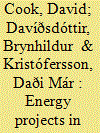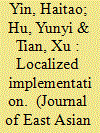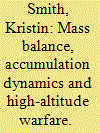|
|
|
Sort Order |
|
|
|
Items / Page
|
|
|
|
|
|
|
| Srl | Item |
| 1 |
ID:
150672


|
|
|
|
|
| Summary/Abstract |
Decision-making in Iceland has occurred without reference to economic valuations of the environmental impacts of energy projects. Environmental Impact Assessments, a legal requirement for nearly all energy projects in Iceland since 1994, have played an important role in identifying the environmental impacts of energy projects, and proposing mitigation measures. However, a purely qualitative description of environmental impacts is insufficient to ensure that they are accounted for equivalently with all of the other costs and benefits of a proposed project. Instead, as monetary information concerning the welfare gains or losses of proposed projects is not currently required to be provided to the licensing body, Orkustofnun, there is the potential for sub-optimal decision-making to occur. As this paper sets out, a broad variety of non-market valuation techniques already exist and could be applied to estimate the value of environmental benefits sacrificed to accommodate such developments. These methods and their outcomes could be incorporated within mandatory cost-benefit assessments for proposed Icelandic energy projects, communicating an estimate of the full welfare implications of approvals to decision-makers and the public alike, and fulfilling an OECD demand for the country to commence such processes.
|
|
|
|
|
|
|
|
|
|
|
|
|
|
|
|
| 2 |
ID:
133109


|
|
|
|
|
| Publication |
2014.
|
| Summary/Abstract |
Growing anxieties over food security have recently brought sharp geopolitical overtones to debates about the agro-food sector. Contending that this 'geopolitical moment' highlights the mutually constitutive nature of geopolitics and political economies of food, we examine how dominant geopolitical framings of food security extend and deepen neoliberal models of agro-food provisioning, and highlight the need for further attention to these dynamics from political geographers. We develop a preliminary research agenda for further work in the field, focusing on the recent spate of global farmland acquisitions, questions of agro-food governance, the securitisation of hunger and obesity, and the environmental impacts of dominant agro-food systems. Throughout, we highlight the value of a counter-geopolitics of food security for re-situating agro-food politics outside hegemonic policies and institutions, and of the alter-geopolitics of food pursued by communities embodying concrete alternative food production and consumption systems.
|
|
|
|
|
|
|
|
|
|
|
|
|
|
|
|
| 3 |
ID:
181840


|
|
|
|
|
| Summary/Abstract |
China's overcapacities in manufacturing industries, including pollution-intensive industries, served as an important motivation of the Belt and Road Initiative (BRI). The popular Pollution Haven Hypothesis (PHH) therefore expects that the initiative will lead to the relocation of polluting industries from China to the recipients. Focusing on the implementation by local governments, we argue that actual outcomes of the BRI depend on the way local states and businesses respond to the BRI in accordance with their preferences. Through investigating industries’ actual responses to the BRI, we found that pollution-intensive industries have not relocated but rather expanded exports to the BRI countries. This has two implications: on the one hand, it alleviates the overcapacity issue in China and helps sustain the economic performance of the industry; on the other hand, it results in more pollution within Chinese borders and aggravates the environmental challenges facing the country.
|
|
|
|
|
|
|
|
|
|
|
|
|
|
|
|
| 4 |
ID:
181953


|
|
|
|
|
| Summary/Abstract |
Since 1984 the Indian and Pakistani armies have been locked in the world’s highest war on Siachen Glacier in the Karakoram Himalaya. This remote location is the world’s only nuclear trijunction as well as a source of drinking water for significant portions of India and Pakistan, and its possession is considered by both governments to be key to their national security. In the past, alpine battles were fought predominantly on glaciers with a precipitation-dominated accumulation type; Siachen, however, gains most of its new ice mass from avalanches and icefalls. This has presented unique challenges in tactics and logistics, rendering many of the strategies of modern conventional warfare useless, and the style of mountain warfare these challenges have produced has impacted both the combatants and the glacier itself. Existing literature on Siachen, while it discusses the verticality of the conflict, has done little to analyze the singular nature of warfare on a high-altitude glacier with an avalanche-heavy accumulation type. This paper draws on USGS Landsat data, glaciological mass balance studies, hydrological studies, firsthand combat accounts and historical reviews of the region to examine the unique tactics, logistics and impact of warfare on Siachen Glacier.
|
|
|
|
|
|
|
|
|
|
|
|
|
|
|
|
| 5 |
ID:
149955


|
|
|
|
|
| Summary/Abstract |
Given the widely acknowledged negative impacts of fossil fuels, both on human health and on potential climate change, it is of interest to compare the impacts of low carbon alternative energy sources such as nuclear energy, hydropower, solar, wind and biomass. In this paper, we review the literature in order to summarise the impacts of the different technologies in terms of their materials and energy requirements, their emissions during operation, their health effects during operation, the accident risks, and the associated waste streams. We follow up these comparisons with some more anecdotal evidence on selected impacts that are either particularly topical or are important but less commonly addressed. These include impacts of wind turbines on persons and on bird life, the underestimated problems with biomass, and concerns about biodiversity reduction. Finally we address the public attitudes towards both renewable energy technologies and to nuclear power. The conclusion is drawn that energy policies of many countries are perhaps more strongly influenced by public and political perceptions of available technologies than they are by rational assessment of the actual benefits and drawbacks. Policy recommendations follow from this conclusion.
|
|
|
|
|
|
|
|
|
|
|
|
|
|
|
|
| 6 |
ID:
166549


|
|
|
|
|
| Summary/Abstract |
Technological change is key to understand the explanatory variables behind environmental impacts in the context of the STIRPAT (Stochastic Impacts by Regression on Population, Affluence and Technology) model. An adequate representation and analysis of the significance of the technology variable (T) in the STIRPAT model becomes crucial, even more if one aims to better understand underlying processes such as the (environmental) rebound effect (E)RE. A critical review of the application of the STIRPAT model has been conducted to understand the diversity and value of the variables, scopes, assumptions, statistical approaches, and the environmental impacts commonly studied. The findings highlight that, despite the multiple applications and the high potential of the STIRPAT model, inconclusive results and/or knowledge gaps remain, notably (1) a geographical imbalance in the scope of studies, (2) the almost exclusive focus on carbon emissions, (3) a lack of agreement on the choice of data, additional explanatory variables, and regression models, (4) a lack of consensus on how to approximate T, and (5) a lack of explicit analyses of the (E)RE. Our findings are useful to both policymakers and academics for method design, further research, and policy evaluation.
|
|
|
|
|
|
|
|
|
|
|
|
|
|
|
|
|
|
|
|
|